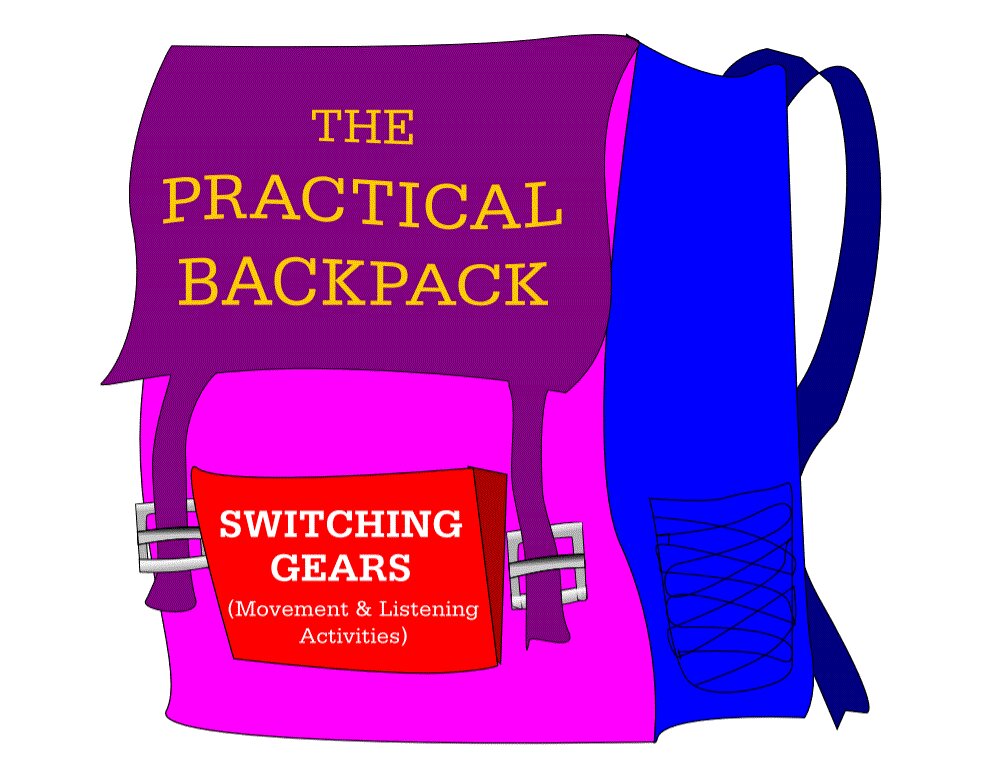THE PRACTICAL BACKPACK

THE PRACTICAL BACKPACK Strategies and tips for situations and behaviors
Welcome to this new blog feature!
Up until now, as you know, Ive been discussing sensory processing issues in detail, sharing information and advice to help you help your children and yourselves.
Now I'd like to introduce an additional feature to this blog. You know I often talk about the importance of building your own personal backpack of strategies that you can rely on to make sensory processing issues easier to manage. Thats why Im going to dedicate some blog posts to listing very specific tactics to try in specific situations, such as what to do if your child is acting out in public, how to ease transitions, etc. Im calling this series The Practical Backpack because youll be able to put practical, concrete ideas straight into your own backpack of strategies.
Activities to use to change engine gears (alertness states)
We've just been discussing The Alert Program: How Does Your Engine Run? so I thought you might find it useful to have lists of specific activities for the five strategies for changing gears.
Many of these strategies will work for either calmingoralerting your child, which is why Ive listed them by type of activity or approach, rather than as calming and alerting strategies. Obviously, the fast movements are for alerting and the slow movements for calming.
Movement activities
Indoor Activities
- Bouncing quicklyorslowly on a therapy ball
- Lying on your belly on a therapy ball and rocking slowly
- Fastorslow rocking in a rocking chair or parents lap
- Fastorslow riding on a rocking horse
- Running, hopping, jumping, skipping, galloping, prancing, etc. for at least 1-2 minutes
- Jumping on a mini-trampoline
- Doing jumping jacks
- Jumping rope
- Hula hooping
- Standing and doing full-body stretches
- Doing animal walks walking like a kangaroo, a horse, a bear, a crab, a penguin, etc.
- Swing your child slowly in a large circle (no spinning)
- Swing your child quickly in a controlled circle (spinning)
- Doing pushups
- Doing wall pushups (push on a wall as if you are trying to move it)
- Doing desk pushups (lean on desk and push yourself up)
- Doing chair pushups (put your hands on either side of your chair seat and use your arms to hold yourself above the seat; you can do this on the floor as well)
- Pushing or pulling open heavy doors, and holding them open
- Hold up your childs legs so s/he can do a wheelbarrow walk on his/her hands
- Doing isometrics: push your hands together palm to palm; hook your fingers together and then pull your hands apart while resisting; push your knee against your hand, etc.
- Pillow fighting
- Pillow crashing: jump or fall into a pile of pillows or thick mats (NOTE: set up by a parent, please!)
- Playing flashlight tag
- Actively squeezing or kneading a stress ball or any resistive object such as clay, play dough, Thera-putty, silly putty, art erasers, squishy toy, etc.)
- Doing heavy work (NOTE: make sure that it is appropriate for your childs size and weight!), such as:
- Pulling or pushing a weighted wheeled backpack, small suitcase, or other rolling cart
- Moving or pushing furniture
- Stacking folding chairs
- Stacking books and/or other heavy objects
- Carrying a stack of books, laundry basket, grocery bags, etc.
- Carrying a weighted backpack or fanny pack
Outdoor Activities
- Taking a brisk walk, run, gallop, skip, etc.
- Jumping on a trampoline
- Running an obstacle course (you can set one up using ordinary objects such as hula hoops)
- Riding a bike, especially up hills (so you are pedaling against resistance)
- Playing in the yard, park, or playground
- Swinging quickly on a playground swing, especially with sudden changes of direction
Spinning on a swing or other playground equipment (NOTE: parent should monitor for both safety and over-stimulation) - Steady, slow swinging while seated on a swing (a good way to calm down before leaving the playground)
Listening activities
- Listening to any music with a fast, strong beat (alerting)
- Listening to classical music
- Listening to nature sounds (water, birdsong, etc.)
- Listening to soft music
- Listening to electronic/instrumental/new-age music (such as Kitaro)
Movement and listening combination activities
- Sitting balanced on an inflatable seat cushion and listening to music or a story (calming)
- Sitting balanced on a therapy ball and listening (calming)
- Bouncing on a therapy ball to the beat of alerting music
- Marching (or any other activity) to the beat of alerting music
Note:
Of course, you should not limit yourself to this list; its a starting point of ideas that you can use to come up with strategies and activities for your own family.
Looking ahead:
I'll be suggesting ideas for touching, looking and mouth activities in the next post (another Practical Backpack entry).
Are there any situations youd like to get some ideas on how to handle?Please share your thoughts in the comments section below. And of course you can always let me know there or via email about any other topics you would like to discuss or hear more about.
Feel free to share or quote from this blog (with attribution, please, and if possible, a link), and to repost on social media.
I look forward to hearing from you!
All the best,
